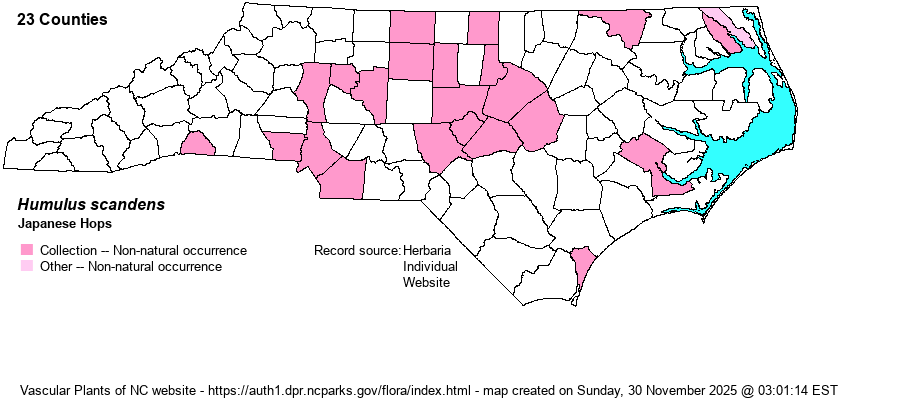| Author | (Loureiro) Merrill | |
| Distribution | Mostly in the Piedmont; rare in the Coastal Plain.
Native of Asia; in N.A. Que. to Ont. and ND, south to GA, AR, KS. | |
| Abundance | Infrequent to locally common in the Piedmont, but rare elsewhere. Easy to find along parts of the Deep, Haw, and Cape Fear rivers. | |
| Habitat | Mainly disturbed places on brownwater river and stream banks, floodplain openings, and alluvial meadows; less often in open disturbed places and in drier/upland sites. | |
| Phenology | Flowering and fruiting June-October. | |
| Identification | Japanese Hops is a long-creeping or scrambling vine that forms rather monospecific patches. Individual stems reach 9 feet long or so, much-branched, and very prickly-haired. Leaves are large and alternate, well-spaced, palmate into 3 broad segments plus 2 or more narrower lobes, margins serrate. Inflorescences are male or female, in leaf axils or terminal, males in open panicles, females in spikes. It is told from H. pubescens by the prickly hairs on the leaf undersides (vs. none) and more leaf lobes (5-9 lobes vs. 1-3 lobes in H. pubescens). | |
| Taxonomic Comments | "The name H. scandens (Loureiro) Merrill (basionym Antidesma scandens Loureiro 1790) has priority over H. japonicus Siebold & Zuccarini 1846" (Weakley 2023).
| |
| Other Common Name(s) | Often written as Japanese Hop. | |
| State Rank | SE | |
| Global Rank | GNR | |
| State Status | | |
| US Status | | |
| USACE-agcp | | |
| USACE-emp | | |

